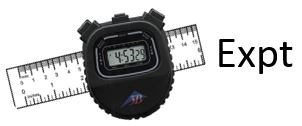Electricity and Magnetism Module 3 Short Version
Table of contents
NOTE: Activities 1-7 can be found in the long version of the Electricity and Magnetism Module 3.
 Activity 8
Activity 8
This is a quick introduction to electric field lines and equipotential lines. If you know these concepts you can safely skip this paragraph and the next paragraph. One way to visualize electric fields is by drawing electric field lines. These lines always come out of positive charges and go into negative charges (unless they form loops, which you will see in second year). They flow in the direction of the electric field at each point in space. If you released a positive test charge in space it would start to move along the electric field line (however due to inertia it would not continue to freely travel along the same electric field line in general). Electric field lines cannot cross (otherwise which path would the test charge follow?) and the density of field lines is a measure of the strength (magnitude) of the electric field in that region.
One way to visualize the electric potential (V) field is to draw lines of equal potential (called equipotential lines). A test charge which moves along an equipotential line does not change its electric potential energy. These lines look a lot like lines of constant elevation on a topographical (geographical) map. Equipotential lines and electric field lines should always be perpendicular. The electric field lines should always point in the direction of decreasing potential.
The dashed lines in the figure below show equipotentials in a region in which there is an electric field. A positive point charge is placed at each of the seven labelled points in turn.
- On the diagram, draw arrows to show the direction of the force on the charge at each of the labelled points. Briefly explain your reasoning.
- Rank the magnitudes of the force on the charge at each of the labelled points, from highest to lowest. Briefly explain your reasoning.
NOTE: Here is a Printable PDF that you can open, print, and staple into your notebook.
 Activity 9 - Electric Field Mapping
Activity 9 - Electric Field Mapping
In this experiment, charges will be placed on conducting surfaces and the electric field set up by these charges will be mapped. In Module 2 you used a battery as a source of voltage. Here you will be using a DC power supply, which has exactly the same functionality.
Part A
A positive charge is moved along dashed paths A, B, C, and D as shown in the figure below. The solid arrows indicate the electric field. For each path, is the total work done by the electric field on the positive charge positive, negative or zero? Be sure to justify your answers.
Using a Multimeter to Find Paths of Zero Work
A multimeter in the DC-V (direct current, voltage) mode can be used to map paths of zero work in an electric field. It's done this way: the negative lead from the black jack is connected to some object whose charge state is constant; this is often the earth ("ground"), which is so large that its surface charge may be regarded as constant. Other objects can be treated as if they were ground, and with the negative lead connected to them.
The lead from the red jack (the positive jack) of the multimeter is then used as a probe to pick a point--any point--and measure its voltage; then the probe is moved over the region to find points in space which provide the same voltage reading. Paths made up of points which are at the same voltage are paths along which zero work would be done if any charge is moved along this path.
Voltage is sometimes referred to as "potential", so the lines or curves of equal voltage are called "equipotential paths", or "equipotential curves", or "equipotential lines". If one can map the equipotential curves of an electric field, one then has only to draw perpendicular curves or lines which intersect the equipotential curves at right angles in order to specify the electric field.
How is the Direction of Electric Fields Determined?
The direction of the electric field lines may be shown by arrows on the field lines; they point toward regions of lower potential, or voltage.
Part B
Sketch several representative lines representing the electric field pattern for the three equipotential patterns shown below. Draw arrows on the lines to show the direction of the electric field.
NOTE: Here is a Printable PDF that you can open, print, and staple into your notebook.
Part C
Sketch the equipotential patterns corresponding to each of the electric field patterns shown below. Label three of the equipotential curves in each diagram "20 V", "10 V", and "5 V". Remember, it is only electric potential differences that have physical meaning; the zero-volt reference is completely arbitrary. Also, the electric field lines point toward regions of lower potential.
Part D. Experiment
You are going to map the electric field patterns set up by pairs of objects that are oppositely charged. One object will be negatively charged, and will be referred to as "ground"; the other object will be positively charged. The pairs of objects are: (i) parallel lines, and (ii) a pair of points. You will be provided with two sheets of black conductive paper that are capable of carrying small current and have painted with conducting silver paint. Since the charged paths will actually be conductive ink electrodes, they will be referred to as electrodes.
NOTE: Here is a Printable PDF that you can open, print, and use to sketch the voltage numbers and patterns you find on the black conductive paper.
-
Choose one of the sheets and place it on your corkboard.
NOTE: The traces for parallel lines have a large silver pad at the midpoint of each line. Use these pads as electrical contacts for the parallel electrodes.
-
Select the red wire with a banana plug on one end, and a ring terminal on the other. Insert the banana plug into the red (positive) jack of the power supply, and place the ring terminal on top of one of the silver pads on the conductive paper. Ensure the flat side of the ring terminal is the side touching the paper, and press a conductive push pin through the ring terminal into the corkboard. Make sure that good metal-to-metal contact is made between the ring terminal and the silver pad.
-
Select the black wire with banana plug and ring terminal, this time connecting the black (negative) power supply jack to the other electrode with another push pin.
-
On the diagram in this handout (not on the black paper), label the corresponding electrode "20 V", and the other one "0 V"; it doesn't matter which one is positive, and which is negative.
-
Select the wires (one red, one black) with a banana plug on one end and a pointed metal rod on the other. These are the probes for the multimeter. Connect the red banana plug to the V-ohm jack and the black banana plug to the COM (common) jack on the multimeter.
-
Switch on your multimeter and select DC-V to enable measurements of voltage (potential). If the display shows "batt", replace the battery of the multimeter.
-
Plug in the power supply, turn it on, and set its voltage to about 20 Volts. You can check the voltage using the multimeter. To prevent the highest voltages to be out of range for your multimeter, use the 200 V setting.
-
The power supply acts just as a DC battery would, so the objects on the corkboard are now charged and have an electric field in the region between them.
-
When measuring potential of a point on the conductive sheet using the multimeter, bring and hold the black probe in contact with the push pin connected to the negative (-) jack of the power supply, bring the red probe in contact with the point of interest, and observe the reading on the multimeter.
When the circuit is complete, it should look something like the photo below.
-
Gently scrape the banana plug over the paper between the two objects until you find a point at which the potential (voltage) is about 5 Volts; don't make any pencil or pen marks on the black paper. Next, find the path from this point along which the potential stays constant at 5 Volts; follow this path wherever it leads, even if the path curves around behind the edges of the objects. This path traces a curve or line called the "5-Volt equipotential line". You may find it easier to plot a series of points rather than tracing a continuous line. For example, you could work across each row of the grid to find the location of the 5-Volt potential, mark these points, and then connect them to obtain the 5-Volt equipotential line.
-
After you have located the 5-Volt equipotential line, sketch its approximate shape and location on the diagram below; it is not necessary to be exact. Label this line "5 V".
-
Repeat Steps 9 and 10 to find the 7.5-V, 10-V, 12.5-V and 15-V equipotential lines.
Keep in mind, as you plot the equipotential lines, that the electric field is strongest in those regions where the equipotential lines are most closely spaced. This is because the electric field E is related to the gradient of the potential field: E = - ΔV/Δr, where ΔV is the change in the potential which occurs over a change in location Δr.
-
The electric field pattern consists of lines or curves which cross the equipotential curves at right angles. Sketch a representative number (15-20) of these electric field lines, and place arrows on a few of them to indicate the direction along which a positive test charge would move if one were placed at that point. Make sure that an electric field curve passes through each of the six small circular points shown on each pattern.
-
In each of the patterns shown, there are tiny circles through which one of the many electric field curves pass. Using the procedure described below, calculate an approximate electric field strength at each one of these points.
Magnitude of electric field strength = |ΔV/Δx|.
(It's |dV/dx|, for those who know calculus.)
This calculation is illustrated in the figure below for Point Q. Locate two points 0.5-cm on either side of Point Q along the electric field line passing through it. Estimate the potential at Points P and R, and subtract the smaller from the larger to get ΔV. Divide this potential difference by Δx, in centimeters (no need to convert to meters). Label each of the six points in each pattern with these numbers.
15. The more closely spaced the electric field lines are in any region, the more intense is the electric field. Looking at your field plots, can you make a generalized statement about how the electric field strength near a conductor depends on the shape of the conductor? If you are doing the dots, note that the shape of a dot is a (small) circle.
This Guide was written in October-November 2007 by Kimberly Strong, Dept. of Physics, Univ. of Toronto.
Activity 1 is based on ILD 10, Representation as Communication: Fields, University of Maryland Physics Education Research Group (Spring 2003) and The Electric Field Mapping experiment, by Joseph Alward and Jason Harlow, Introductory Laboratories, Physics Department, University of the Pacific (2004). Activities 2, 3, and 4 are taken from Randall D. Knight, Student Workbook (Pearson, 2004). Activities 5, 6, 7, and 8 are taken from Curtis J. Hieggelke et al., E&M Tipers: Electricity and Magnetism Tasks (Pearson Prentice Hall, 2006). Activity 9 is based on The Electric Field Mapping experiment, by Joseph Alward and Jason Harlow, Introductory Laboratories, Physics Department, University of the Pacific (2004).

